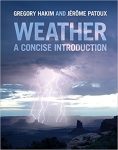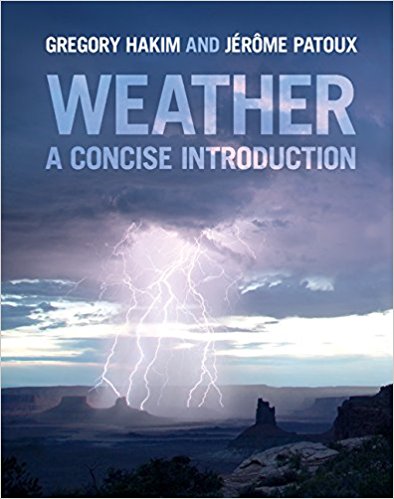 Authors: Gregory Hakim, PhD and Jerome Patoux, PhD
Authors: Gregory Hakim, PhD and Jerome Patoux, PhD
Publisher: Cambridge University Press – 268 pages
Book Review by: Sonu Chandiram
This is an introductory textbook on meteorology designed for students who may have no background in mathematics and science. It is a clear, concise, and informative text on weather, and it provides students with a strong foundation in the physical, dynamical, chemical, and other types of processes taking place in the atmosphere.
Among the important benefits of having this book are, that it:
- Provides a concise and practical approach to understanding the atmosphere
- Introduces the basic physical laws early on and then ties them together with a single case study spanning the book
- Presents weather analysis tools early in the book to allow instructors to engage in discussions of current weather in tandem with the basic concepts, thus attracting and retaining student interest
- Facilitates students’ learning and understanding of the fundamental aspects of weather analysis and forecasting, as well as practical skills, through a careful description of the forecasting process, Modern methods, such as ensemble forecasting, are central to the approach.
This large book provides numerous images of various types, including charts, drawings, photos, schematics, sketches, tables, and other types of graphics to convey concepts, ideas, facts, and points in a clear manner. The idea that “a picture is worth a thousand words” has been definitely put into practice in this book.
The range of topics covered in this book relating to the weather is wide. This list of chapter titles we provide you below gives a good overview:
- Weather Variables
- Spatial Representations of Weather Data
- Our Atmosphere: Origin, Composition, and Structure
- Heat and Energy Transfer
- Water
- Cloud Formation
- Precipitation
- Wind
- Global Wind Systems
- Air Masses, Fronts, and Midlatitude Cyclones
- Thunderstorms and Tornadoes
- Tropical Cyclones
- Weather Forecasting
- Air Pollution
- Climate Change and Weather
Case Study: February 2014 Cyclone: The main concepts of the book are illustrated chapters 2 to 13 by a single case study: a midlatitude cyclone that swept the eastern half of the United States between February 19 and 22 in 2014. This case study is a single thread running throughout this book, providing students a strong basis to study it from multiple perspectives
“Viewing the storm in the context of different topics provides a familiar setting for mastering new subjects and for developing a holistic understanding of midlatitude cyclones,” the author writes in the Preface.
This book has the following features that make it easier to learn from it:
- Appendices for additional coverage
- Boxes on more advanced topics
- Charts, figures, maps
- Key terms and glossary
- Instructor resources
- Systematic organization of materials
This is an excellent introductory textbook on meteorology and the various aspects of weather.
Authors:
Gregory Hakim has undergraduate degrees in Mathematics and Atmospheric Science and a PhD in Atmospheric Science from the University at Albany, State University of New York. He joined the Department of Atmospheric Sciences at the University of Washington in 1999 where he served as Department Chair from 2012 to 2017 and is currently a Professor. He is also a leading scientist in the areas of weather analysis, predictability, and dynamics, and his research interests include weather and climate prediction, hurricanes, past climates, and polar circulation patterns.
He has served on the advisory panel for the Department of Geosciences at the National Science Foundation, is Chair of the advisory panel for the Mesoscale and Microscale Meteorology Laboratory at the National Center for Atmospheric Research (NCAR), as a member of the NCAR Advisory Panel, as a member of the NCAR Strategic Planning Council, and as Chair of the University Corporation for Atmospheric Research’s President’s Advisory Committee on University Relations.
Jerome Patoux earned a Master in Environmental Engineering from the University of Texas at Austin and a PhD in Atmospheric Science from the University of Washington. He has been funded by the National Science Foundation (NSF), the National Aeronautics and Space Administration (NASA), the Office of Naval Research (ONR), and the National Oceanic and Atmospheric Administration (NOAA). He has taught undergraduate introductory meteorology for many years, and has been funded by the NSF to develop a weather and climate curriculum. He is a former faculty member from the Department of Atmospheric Sciences at the University of Washington, and currently teaches meteorology at the University of Nantes in France.







